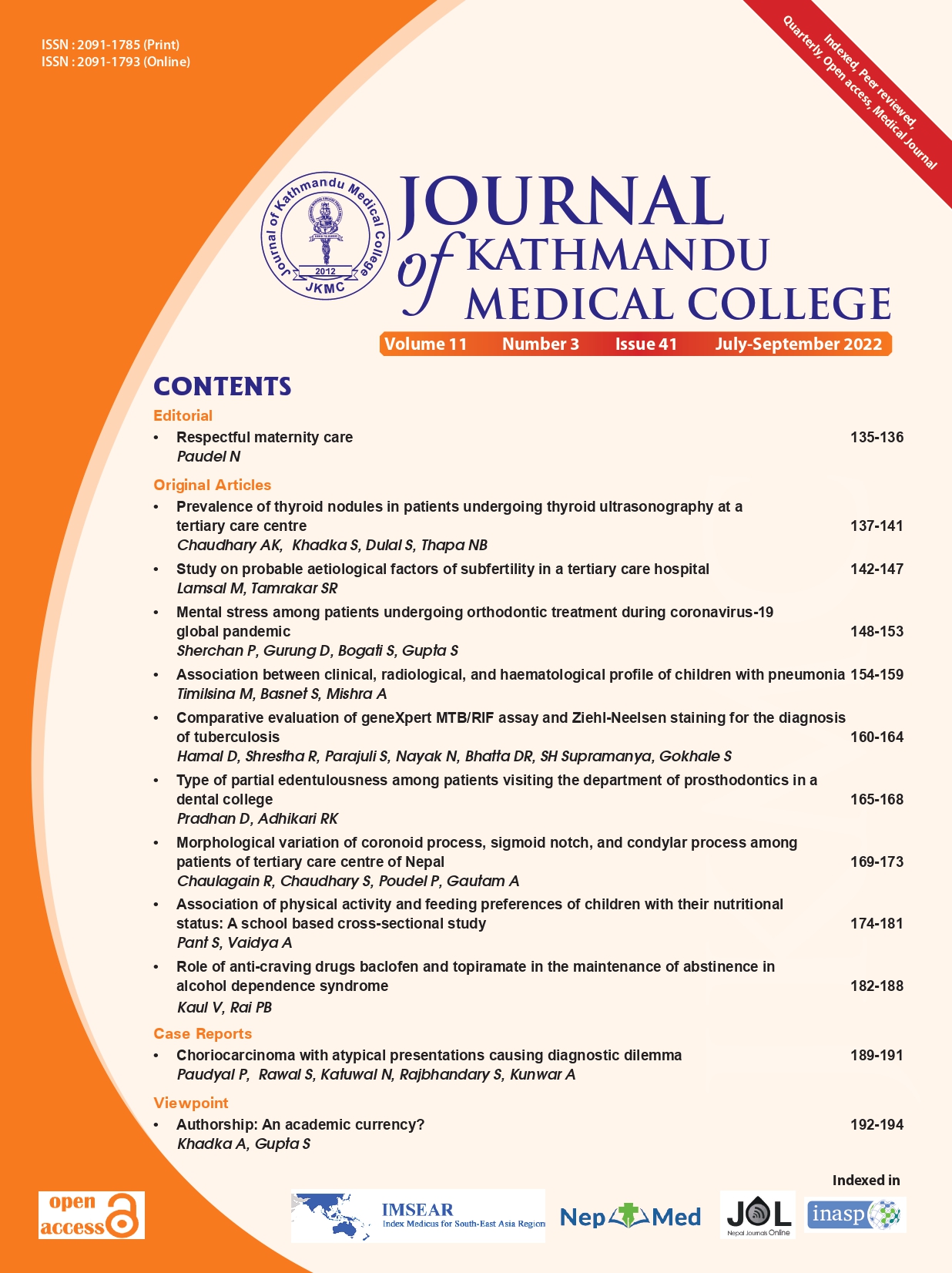Association of physical activity and feeding preferences of children with their nutritional status: A school based crosssectional study
DOI:
https://doi.org/10.3126/jkmc.v11i3.50790Keywords:
Body mass index, Child, Obesity, Overweight, ParentsAbstract
Background: People who are obese have a higher risk of acquiring many severe diseases. Feeding preferences and physical activities are deemed to play an important role in obesity in children.
Objectives: This study aimed to find out the prevalence of over nutrition among primary level children in selected private schools of Kathmandu Metropolitan City (KMC). It also assessed the impact of physical activity level and feeding preferences on their nutritional status.
Methods: An analytical cross-sectional study was done among 488 children and their parents, in six schools of KMC between May and August 2016. Children with written permission were included in the study, while absentees or hostel dwellers were excluded. Multistage cluster sampling was used for sampling. Ethical clearance was obtained from Institutional Review Committee of Kathmandu Medical College Public Limited and informed consent was taken from all participants. The questionnaire contained questions regarding socio-demographic details, modified Child’s Feeding Questionnaire and Child Physical Activity Questionnaire. Data was entered and analysed using SPSS v.20.
Results: The prevalence of overweight was 4.5% (22) and obesity was 2.5% (12). Similarly, 135 (27.7%) children had adequate physical activity per day. Those with adequate physical activity were 1.5 times more likely to be overweight. Parent’s perception of their child’s weight and their concern about their child being overweight were both predictors of the child’s actual weight.
Conclusion: Nutritional status of children was affected by feeding preferences of their parents, so they need to be educated about the importance of healthy eating and physical activities.
Downloads
References
National Health Services. Malnutrition: Overview. UK: National Health Services; 2020. [Full Text]
Unite for Sight. Over nutrition: Unite for Sight.USA: Unite for Sight; 2021 [cited 2021 May 26]; [Full Text]
National Academies of Sciences, Engineering, and Medicine. Current status and response to the global obesity pandemic: Proceedings of a workshop. Washington: National Academies Press; 2019[cited 2021 May 26]; [Full Text]
World Health Organization. Obesity and overweight. Geneva: World Health Organization;2020[cited 2021 May 29]; [Full Text]
National Centre for Chronic Disease Prevention and Health Promotion, USA. Adult obesity causes & consequences .Georgia: Centres for Disease Control and Prevention, USA; 2021[cited 2021 Jun 1]. Full Text]
World Health Organization. Noncommunicable diseases: Childhood overweight and obesity . Geneva: World Health Organization; 2020 [cited 2021 Jun 2]. [Full Text]
Koirala M, Khatri RB, Khanal V, Amatya A. Prevalence and factors associated with childhood overweight/ obesity of private school children in Nepal. Obes Res Clin Pract. 2015 May 1;9(3):220-7. [PubMed | Full Text | DOI]
Shan X. Influence of parents’ child-feeding practices on child’s weight status among Chinese adolescents in Beijing, China. Southern Illinois University at Carbondale; 2010 Oct 18 [cited 2021 Jun 4]. [Full Text]
MRC Epidemiology Unit. Physical activity downloads. Cambridge: University of Cambridge; 2020. [cited 2021 Jun 7]. [Full Text]
Centres for Disease Control and Prevention. Defining childhood obesity. USA: Centres for Disease Control and Prevention; 2018 [cited 2021 May 29]. [Full Text]
World Health Organization. Physical activity. Geneva:World Health Organiztion; 2020[cited 2021 May 29]. [Full Text]
Acharya B, Chauhan HS, Thapa SB, Kaphle HP, Malla DJ. Prevalence and socio-demographic factors associated with overweight and obesity among adolescents in Kaski district, Nepal. Indian J Community Health. 2014 Dec;26(Supp 2):118-22. [Full Text]
Gaurav K, Poudel IS, Bhattarai S, Pradhan PMS, Pokharel PK. Malnutrition status among Under-5 children in a hill community of Nepal. Kathmandu Univ Med J. 2014;;48(4):264-8. [PubMed | Full Text | DOI]
Sah VK, Giri A, Acharya RJ. Prevalence of overweight, obesity and its associated risk factors among school children aged 6-16 years of Biratnagar. J Nobel Med Coll. 2016 Dec ;5(2):22-5. [Full Text]
Karki A, Shrestha A, Subedi NJ. Prevalence and associated factors of childhood overweight/obesity among primary school children in urban Nepal. BMC Public Health. 2019 Aug 6;19(1):1-12. [PubMed | Full Text | DOI]
Gebremichael B, Chere A. Prevalence of childhood overweight and obesity and its determinant factors among elementary school children in Addis Ababa, Ethiopia: A cross-sectional study. J Nutr Disord Ther . 2015 Jun 25;1:2161-0509. [Full Text]
Bassett Jr DR, Tremblay MS, Esliger DW, Copeland JL, Barnes JD, Huntington GE. Physical activity and body mass index of children in an old order Amish community. Med Sci Sports Exerc. 2007 Mar;39(3):410-5. [PubMed | Full Text | DOI]
Downloads
Published
How to Cite
Issue
Section
License

This work is licensed under a Creative Commons Attribution-NonCommercial 4.0 International License.
Copyright © Journal of Kathmandu Medical College
The ideas and opinions expressed by authors or articles summarized, quoted, or published in full text in this journal represent only the opinions of the authors and do not necessarily reflect the official policy of Journal of Kathmandu Medical College or the institute with which the author(s) is/are affiliated, unless so specified.
Authors convey all copyright ownership, including any and all rights incidental thereto, exclusively to JKMC, in the event that such work is published by JKMC. JKMC shall own the work, including 1) copyright; 2) the right to grant permission to republish the article in whole or in part, with or without fee; 3) the right to produce preprints or reprints and translate into languages other than English for sale or free distribution; and 4) the right to republish the work in a collection of articles in any other mechanical or electronic format.




